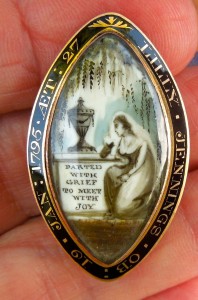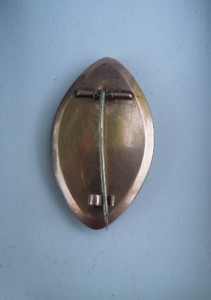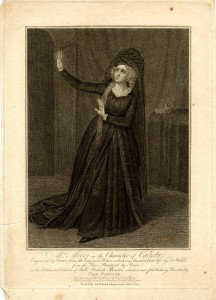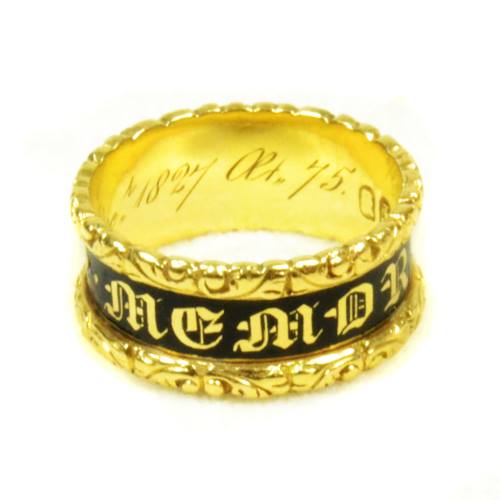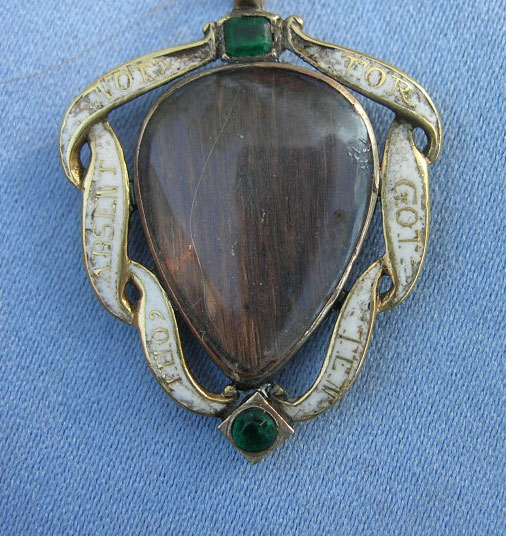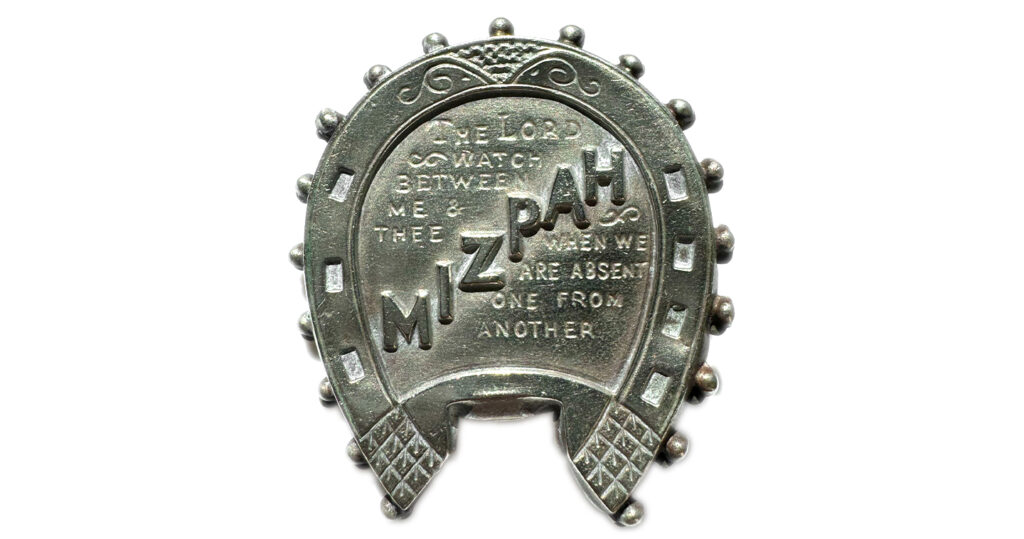Parting with Grief Mourning Brooch, 1795
Lilly Jennings passed away on the 19th of January, 1795 at the age of 27. When a person leaves behind their imprint upon a jewel, it resonates within a family and lets the viewer of the jewel understand the time, place and happenings of when it was created. Hence, the life that someone had lived and the memory that they had given may have been lost in an intrinsic way, but also amplified for a new audience hundreds of years later.
In this brooch, there are several elements of personal grief on display, painted at a time when the humanist movement had depicted the self in Neoclassical renditions. As a brooch made with black enamel, the subject, in this case Lilly Jennings, was considered to be married, or at least had been, rather than the white enamel of an unmarried, or young, girl. One must look at who would have worn this in costume, to the neck or bodice, which may have been the mother, sister or daughter. Lilly died at 27, which was a respectable age at a time when the mortality rate was averaging around 40, but still young for a daughter to have such a piece. Through this, we look to the central female mourner. The lady in wearing fashionable mourning clothes for the time, but also, her face is highly rendered, personalising the piece for the wearer.
In the 1790s, the ability to have very bespoke mourning depictions was influenced by the standardisation of style and the amount of artists there were to either tailor a portrait, or paint one on commission. As a developing style, the 1780s saw a great influx of the mourning depiction in jewels, ranging from rings to bracelet clasps. By the 1790s, colour was a popular element to introduce into the sepia paintings (on ivory or vellum). This was popular enough to the extent that the raw, painted ivories were being sold by travelling salesmen to sell from town to town and customised through the message and people within the depictions for lower costs. The Napoleonic Wars made this even more popular, as departing soldiers would have Neoclassical portraits tailored to their features (with the original being the Neoclassical idealised face).
To discover more about this brooch, let’s look to its various elements and see how each works within the other to create this statement of grief and love.
Costume
The lady in mourning interacts with her scenario through the use of her body language and costume. Having such high detail in the painted rendering makes her the focal point of the piece, with the urn being an accessory to the message of the brooch.
Her costume shows her motion, by covering her whole lower body, yet her legs shows the genuflection to the tomb and reverence is seen in the drapery of her dress across her knees, thighs and feet. The detail to the shadow and the drapery gives the costume a fluid dimension, rather than just being crudely shaded; her body is gathered in detail.
Post 1760, the Neoclassical movement had crept into the previously fashionable Rococo style of costume fabrics. Elaborate Rococo floral motifs moved to simple stripes or smaller motifs. Side hoops were discarded and lighter silks and cotton was introduced, with much influence being from the aristocracy. Marie Antoinette was painted in La reine en gaulle, by Elisabeth Vigée-Lebrun, 1783, introducing a new style that reflected the peasantry, showing a muslin chemise, straw hat and belt at the waist. The introduction of this fashion resonated through mourning costume and can be seen in this brooch.
The female mourner’s high waistline and lower cut bodices is trimmed in white, with long, narrow sleeve ending at white cuffs. Her hair is framed with a white veil, which is pulled back to reveal her hair (rather than the normal veil framing the face), but that only leads to the intimacy of the piece.
The 18th century welcomed in greater convention for mourning fashion and began to see the rise of the mourning industry. This became so much so that mourning dress was becoming desirable and the difference between mourning and non mourning dress was narrowing. Much of the fashion in this century was dictated by the fabric rather than the cut, and the silk industries in France and England held major influence on mourning wear because of this. It was Ordre Chronologique des Deuils de la Cour, (1765) where details of Court mourning in France were published, giving precise tailoring instructions. From their first days in mourning, men were permitted to appear in Court, unless it was after the death of a parent from whom they had received inheritance.
Widows had to wait one year and six weeks, with the first six months in black wool. Lord Chamberlain and Earl Marshall both ordered shorter periods of mourning in France and England respectively.
As in the 17th century, black and plain were required. Bombazine dresses trimmed in black crape, black silk hoods and plain white linen were worn with black shammy leather shoes, glove and crape fans. Jewellery was not permitted. Second mourning consisted of black dresses, trimmed with fringed or plain linen, white gloves, black or white shoes, fans and tippets and white necklaces and earrings as necessary. Grey lusterings, tabbies and damasks were acceptable for less formal occasions.
Ordre Chronologique des Deuils de la Cour was specific and influential enough to decide upon women’s fashions, as. It was specific enough to specify that; ‘dress was cut with a train and turned back with a braid attached to the side of the skirt, which was pulled through the pockets.’ This is where the overskirt is turned to the back and lifted up, revealing the petticoat underneath, called; robe retrousee dans les poche, the centre front robings were joined with hooks or ribbons. Cuffs were cut with one fold and deep hems, the waist was held in place by a crape belt that was tied on. This left two ends hanging down to the hem of the skirt.
A woman’s accessories were a crape shawl, gloves, shoes with metallic bronzed buckles, a black woollen muff and a black crape fan. Head dresses of black crape and white batiste were referenced. For much of the century, however, ‘paniers’ were fashionable, but in the French style, with loose pleating falling from the shoulders to the back. The English manner of this was with the back pleats stitched down as far as the waistline. Also popular were lace ruffles at the neck and the cuff, embroidered stomachers, silver gilt lace, appliqué work and small aprons. None of these were permitted for mourning wear. Mourning wear for women still remained consistent in that it remained plain, black or sometimes white fabric.
Perhaps the last, and most important element is that her hand is pointing towards the sentiment written upon the tombstone, giving her body posture three separate meanings; respect to the deceased, personal grief and a message for those who are viewing the brooch; that the deceased has parted with grief to meet with joy.
“Parted with grief to meet with joy”
As an element that contains the most gravity, the direct sentiment that the lady is pointing towards. This is due to this being an element which could be chosen by family to have written by the artist upon the piece (regardless if it was pre-designed or not). Looking at the words themselves tells a tale about what the reason for death was, while in other cases it may be more of a statement from a family member as a statement of their own grief.
Grief, as a message, is directed at the deceased, which leads the concept of departing after a struggle with illness or some imposition upon them. However, the grief, which is their mortality, is met with joy in the afterlife, as they have gone on to heaven and are at peace. As a contrast, the weeping female is clearly in grief as she points to the message, and her highly detailed face depicts the sadness that she feels for the loss of this union.
When viewed in context with its contemporary jewels, the message makes more sense when directly applied to the subject. Many other sentiments weren’t as direct (or more esoteric) than this, applying themselves to grander concepts of family, friendship or youth. From these, there are more elements that were previously designed and not tailored to the piece, but in this brooch, we see it very personal.
Another telling sign is that the text is in a different hue than many of the colours that surround it. In the sepia pieces, it is more pronounced, yet here we need to see the contrast of the text with the design of the tombstone itself. The tombstone is quite dull and has broader, thicker strokes, yet the text is crisp and dark.
Urn
The urn itself is a vessel, or more specifically a vase, which naturally have their beginnings in pre-history when humanity began gathering items in order to carry them. We won’t be dwelling on this form of history, but rather the ancient Greek use of the urn in artistic depictions. The urn itself had evolved as a decorative item, often with art displayed upon the vessel itself prior to Greece in neighbouring Mediterranean societies, but its interpretation in jewellery design stems mostly from the Greek and Roman scenes in art and their reinvention during the Neoclassical period.
Usage of the urn had never wavered, however. Cremation of the body and the collection of ashes in the urn is a method that survived ancient civilisations well into the Dark Ages. The name itself is derived from the Latin ‘uro’, meaning ‘to burn’, so no matter what the shape of the vessel the title was always ‘urn’. This is a concept that never left the mainstream mind and its uptake as a Neoclassical symbol and its consistency as a funerary motif is simply a natural evolution for the urn’s depictions.
While burial became the more popular method of interment, the urn still retained its status as a symbol of death, testifying the death/decay of the body and into dust and the departed spirit resting with god.
This brings us to the draped urn. The draped urn itself often denotes the death of an older person, however, the drapery is often a constant when in relation to death. Interpretations of this can be when the shroud drapery denotes the departure of the soul towards heaven in relation to the shroud over the body, the drape is the partition between life and death or that it is guarding the sacred contents of the urn itself. In jewellery, finding the urn draped or undraped is quite common, but why is it so?
As hinted at before, the urn is a motif that reached incredible heights of popularity in Neoclassicism due to its interpretation from the original classical depictions. It was a motif that was easily lifted from its source and fulfilled all the classical resonance that a revival period needed to convey the style of its respective era. With the focus back upon the personal nature of mourning and the departure of the direct link towards god, death itself became something worn prominently in mainstream fashion. The urn was a perfect way to show this, draped or undraped. Sitting on top of a plinth, column or tomb, the urn is often the central focus of the mourning depiction. The mourning character in the depiction (male or female) is often interacting with the urn in some way, either leaning against it weeping, sitting near it, standing beside it or looking at it directly. This links the personal nature of mourning from the person into the jewel itself. The mourner is the wearer or the person who created the dedication and the urn represents the loved one. Consider that; there’s a direct link in methodology of the urn to the self, this is why the urn is the central motif and not the mourner.
Consider that when looking at a brooch, ring, bracelet clasp, pendant or any other peripheral from the late 18th to early 19th centuries. The urn is the concept that should draw the eye and take precedence over everything else.
Yet, it is a symbol that disappeared soon after the first quarter 19th century. If you’ve read anything else on this blog, you’ll know that the Gothic Revival period played a key role in reverting society back to more ‘traditional’ values and using a direct relation to the body in the urn conflicts with the burial/god connection which was part of the social understanding of life and death, that Christian values returned to a life under god. You can find the urn in use to around the 1820s, but many of the latter uses in jewels are anachronistic in the same way that memento mori would have been during the late 18th century. However, in funerary, the urn was still retained and is to this very day. In fact, its use in architecture in the latter 19th century / early 20th century was quite typical, but it had largely disappeared as a motif to represent the self in mourning.
Willow
One issue that many Neoclassical pieces suffer from is the replacement of the glass by modern antique dealers. In many cases, sepia and colour can be touched up to look crisper and the replacement of the glass shows a higher bevelled edge, whereas the original may have had detail painted upon the underside of the glass itself.
The weeping willow is heavily symbolic of grief, sorrow and mourning, even physically, it stands as an analogy to human grief, with its back bent over the subject, be it a weeping figure, a tomb, plinth or any other mourning subject.
One of the better descriptions of the weeping willow comes from 2020site.org and this marvellous excerpt:
“Though the Weeping Willow is commonly planted in burial grounds both in China and in Turkey, its tearful symbolism has been mainly recognized in modern times, and among Christian peoples. As has been well said: “The Cypress was long considered as the appropriate ornament of the cemetery; but its gloomy shade among the tombs, and its thick, heavy foliage of the darkest green, inspire only depressing thoughts, and present death under its most appalling image, whilst the Weeping Willow, on the contrary, rather conveys a picture of the grief felt for the loss of the departed than of the darkness of the grave. Its light and elegant foliage flows like the disheveled hair and graceful drapery of a sculptured mourner over a sepulchral urn, and conveys those soothing, though melancholy reflections…”
So, where can one find this in jewellery? Quite commonly, it became one of the most used symbols of the Neoclassical period, so look for it on miniatures set into bracelets, pendants, etc and to a lesser extent was used in the 19th century. It can still be found in cemeteries and on peripheral funeralia today.
In this brooch, one can clearly see the painting on the reverse of the glass, which enhances the willow itself. It is a perfect jewel for its time and remarkable that it has survived over two hundred years in pristine condition.
As an element, the willow is one of the most typical of the Neoclassical era, and as can be seen here, is most typically framing a mourning depiction.
Black Enamel
Finally, the black enamel reflects the sensibilities of Lilly’s social status most of all. Rather than knowing that she had a female relation or friend who was living to wear this brooch, the black enamel shows her relationship status (either married or widowed) and that it was clearly denoting death.
Within, the text denoting her name and date of death is balanced with the sheaf design at the north is bespoke and designed by the jeweller. One thing to note about these designs is just how they are always perfectly balanced in their typography. It is more common to have awkward design to the sentimental memento in the Neoclassical depiction, but the jeweller’s enamel around the border of a piece is rarely awkward.
Enamel, as seen in the ring above, has been the most popular identifier of mourning jewellery, due to its use in the 19th century. Following the Gothic Revival, black enamel was adopted as the primary method of stating the jewel being created for mortality. Further to this, white, blue and red enamel were used for their specific reasons (white being the death of a child or unmarried person, denoting purity and virginity, blue for those where were considered royalty).
The ribbon motif was an important one in Rococo jewels, as it was a clear break from the pre-1740 pieces. Rings, which were more typical to have the enamel surround and dedication inlay, evolved this shape, while pendants and brooches (such as the Georgian Heart seen above) evolved from the ‘Stuart Crystal’ style of having the crystal centre/hair underneath into adapting the enamel surrounding. As Rococo allowed for this, the shapes became more streamlined in the latter 18th century and evolved the bolder 19th century styles.
For more on the ribbon and the heart motif, please read the following articles:
> Georgian Heart with Hairwork Twist in Crystal, 1824
> Three-Dimensional Urn Locket, Garnets, Pearls and Ribbon!
> Georgian Eye Miniature Inside a Pendant, c.1820
> Late Georgian Heart Pendant With Hairwork
> Rien Sans Amitie, Cabochon Garnet French Mourning Locket
> Merit Claims Esteem/Bow Heart Locket, 18th Century
> French Ribbon Pendant, 18th Century
> 18th Century Ribbon Motif Pendant
> An Eternity Knot in a Crystal Heart Pendant
> Mourning Crystal “Georgian” Heart
> Stuart Crystal Heart Pendant with Angels and Crown
> Memento Mori Stuart Crystal Heart
> Diamond Navette Ring, Late 18th Century
> 18th Century Diamond Fede Ring
> Late Georgian Heart Pearl Pendant 19th Century
> The Hon Alice Nugent in a 1730 Mourning Locket and the Hairwork Eternity
> Is It, Or Isn’t It? Heart Pendant – First Impressions
In this style, we have a clear continuity to the Rococo ribbon motif that was popular from the 1740s, while it is only streamlined and simple in the style of the Neoclassical era. Even previous to this, the surrounding of a ring in the 17th century of enamel and with the name inscription was a typical one, but that is the purpose of a mourning/sentimental jewel; to announce the affection of the wearer or their status.
As per style, the brooch lends itself more towards the rings of the 17th century, which introduced much of the external enamel dedication. As can be seen in the above example from 1699, the enamel inlay was part of the design, as much as the actual statement of the jewel.
A clearer statement is made by this skeletal ring from around the same time as the ring above it. What can be seen in the continuity is that if it wasn’t simply the statement of the death/name of the deceased, the symbolism was used in the same context to denote mortality and love.
Lilly Jennings
Scenarios of mourning are wonderful insights into the personal behaviour of earlier times. Much can be seen in ideallic paintings that are contemporary to a certain date of death, but when you have a token of love made specifically for a person in mourning, then you have more interpretation of what their personal sensibilities were. This brooch for Lilly Jennings is the ideal of its time and the most sentimental to the person who commissioned it. That it has survived time so well only allows us to look back and reflect upon a moment that has been defined by other forms of media to see its truth.




